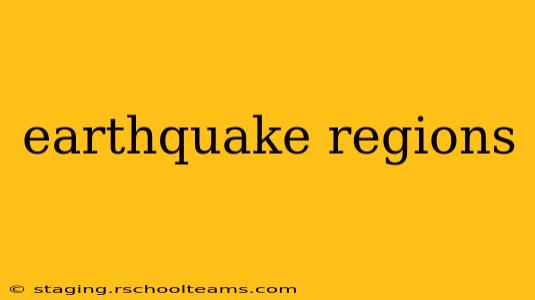Earthquakes, powerful and unpredictable forces of nature, are a significant global hazard. Understanding earthquake regions is crucial for mitigating risks, developing resilient infrastructure, and ensuring public safety. This comprehensive guide explores the major earthquake zones worldwide, the underlying geological causes, and the implications for communities living in these areas.
Understanding Seismic Activity and Plate Tectonics
Before delving into specific earthquake regions, it's essential to grasp the fundamental science behind these events. Earthquakes are primarily caused by the movement of tectonic plates—massive slabs of Earth's lithosphere. These plates constantly interact, colliding, separating, or sliding past each other. The friction along these boundaries builds up stress, which is eventually released as seismic waves, resulting in an earthquake.
Types of Plate Boundaries and Earthquake Risk:
-
Convergent Boundaries: Where plates collide, often resulting in subduction (one plate sliding under another). These zones are associated with the most powerful earthquakes, often accompanied by volcanic activity. Examples include the Pacific Ring of Fire.
-
Divergent Boundaries: Where plates move apart, typically creating mid-ocean ridges. Earthquakes here tend to be less powerful than those at convergent boundaries. The Mid-Atlantic Ridge is a prime example.
-
Transform Boundaries: Where plates slide past each other horizontally. The San Andreas Fault in California is a classic example of a transform boundary, generating significant seismic activity.
Major Earthquake Regions of the World
Several regions are particularly prone to significant earthquake activity due to their location along tectonic plate boundaries.
1. The Pacific Ring of Fire:
This horseshoe-shaped zone encircling the Pacific Ocean is the most seismically active region on Earth. It's characterized by a high concentration of volcanoes and frequent, powerful earthquakes. Countries within the Ring of Fire, including Japan, the Philippines, Indonesia, and the west coast of the Americas, experience considerable earthquake risk. The subduction zones along this ring are responsible for the immense energy released during major seismic events.
2. The Mediterranean-Himalayan Seismic Belt:
Stretching from the Mediterranean Sea to the Himalayas, this belt is another highly active earthquake zone. The collision of the African and Eurasian plates is the driving force behind the frequent earthquakes in this region. Countries such as Italy, Greece, Turkey, Iran, and Pakistan are particularly vulnerable. This area also experiences a high frequency of moderate to large earthquakes.
3. The Mid-Atlantic Ridge:
Although less prone to devastating earthquakes than convergent boundaries, the Mid-Atlantic Ridge, a divergent plate boundary, still generates significant seismic activity. The spreading of the plates along this ridge causes frequent, albeit typically smaller, earthquakes.
Preparing for Earthquakes: Mitigation and Resilience
Living in earthquake-prone regions necessitates proactive measures to mitigate risks and build resilience. This includes:
Earthquake-Resistant Construction:
Building codes and engineering practices must be adapted to withstand seismic forces. This involves using robust materials, employing specific structural designs, and implementing earthquake-resistant foundations.
Early Warning Systems:
Advanced monitoring networks and early warning systems can provide crucial seconds or minutes of warning before an earthquake strikes, allowing for immediate actions to minimize casualties.
Public Awareness and Education:
Educating the public about earthquake preparedness, including emergency procedures, safe practices during and after an earthquake, and the importance of disaster kits, is vital for community resilience.
Conclusion: A Continuous Challenge
Understanding earthquake regions is a crucial step in mitigating the risks associated with these powerful natural events. Continuous research, technological advancements, and community preparedness are essential for building safer and more resilient communities in seismically active areas worldwide. Ongoing monitoring and improved forecasting remain vital priorities in minimizing the impact of future earthquakes.
